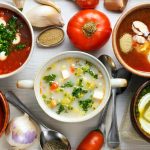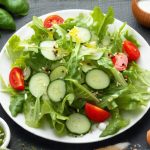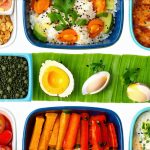Gastroesophageal reflux disease (GERD) can significantly impact dietary choices, often leading individuals to restrict foods they enjoy for fear of triggering symptoms like heartburn, regurgitation, and discomfort. Casseroles, traditionally comforting and convenient meals, frequently fall into this restricted category due to ingredients known to exacerbate GERD – high fat content, acidic tomatoes, spicy seasonings, and even certain vegetables. However, with mindful ingredient selection and careful preparation techniques, it is possible to create delicious and satisfying casseroles that are gentle on the digestive system. This article will explore how to build flavorful, GERD-friendly casseroles that reheat well, offering a practical solution for busy individuals seeking both comfort food and symptom management.
The key to enjoying casseroles with GERD lies in understanding which ingredients tend to trigger reflux and then finding suitable alternatives or modifying preparation methods. For example, swapping high-fat proteins like beef for leaner options such as chicken breast or fish can reduce the likelihood of symptoms. Similarly, using low-acid tomato products, or even omitting tomatoes entirely and relying on other flavor bases, minimizes irritation. And crucially, focusing on gentle cooking methods and portion control helps prevent overfilling the stomach, a common reflux trigger. This isn’t about deprivation; it’s about adapting classic recipes to support digestive health while still enjoying enjoyable meals. Consider starting your day with one of these 7 easy breakfasts that calm acid reflux symptoms, setting a positive tone for the day!
Building Blocks of GERD-Safe Casseroles
The foundation of any good casserole starts with ingredient selection. Prioritizing low-fat proteins is crucial – think skinless chicken breast, turkey, white fish (cod, halibut), or even plant-based protein sources like lentils and beans (in moderation). Carbohydrates should lean towards easily digestible options like rice, potatoes (baked or boiled, not fried), quinoa, or whole wheat pasta. Vegetables are fantastic, but certain ones are more GERD-friendly than others; broccoli, cauliflower, and Brussels sprouts can contribute to gas and bloating in some individuals, so smaller portions or avoiding them altogether might be necessary. Green beans, carrots, spinach, peas, and zucchini are generally well-tolerated choices. The biggest consideration is often the sauce base – creamy sauces made with heavy cream should be avoided, replaced instead by lighter alternatives based on broth, yogurt, or blended vegetables. If you’re traveling, remember to pack foods that calm an upset stomach!
The choice of dairy also matters. Full-fat dairy products can exacerbate GERD symptoms due to their higher fat content and potential for delayed gastric emptying. Opting for low-fat or non-fat versions of milk, yogurt, and cheese is advisable. However, even these should be used in moderation as lactose intolerance can sometimes accompany GERD. Finally, spices are a double-edged sword: while they add flavor, highly spiced foods are known triggers. Mild herbs such as basil, oregano, thyme, and parsley are generally safe; avoid chili powder, cayenne pepper, garlic, onions, and black pepper if you’re sensitive. Remember that individual tolerances vary greatly – what bothers one person may not bother another.
Reheating Without the Regret: Maintaining GERD-Friendliness
A major benefit of casseroles is their ability to be made ahead of time and reheated, making them ideal for busy schedules. However, reheating can sometimes alter a dish’s composition and potentially increase GERD symptoms. The key here is to avoid methods that add fat or promote prolonged cooking. Microwaving is often the most gentle option, as it heats food quickly without adding extra fats. If using an oven, lower temperatures (around 300°F/150°C) are preferred and reheating for shorter periods minimizes the risk of overcooking and increasing acidity. Adding a splash of water or broth to the casserole before reheating helps maintain moisture and prevents drying out, which can sometimes lead to increased spice concentration.
Furthermore, portion control remains essential even during reheating. Overeating, regardless of how gentle the food is, will likely trigger symptoms. It’s better to reheat only what you plan to eat immediately rather than reheating an entire casserole and then consuming large portions. Pay attention to your body’s signals – if you experience any discomfort after reheating or eating, adjust the ingredients or methods for future preparations. The goal is not just to have a convenient meal but also a comfortable one. To help with digestion, consider these fermented breakfast recipes that rebuild gut flora.
Gentle Flavor Infusions: Beyond Tomatoes
Many traditional casseroles rely heavily on tomato-based sauces. While some individuals can tolerate tomatoes in small amounts, they are often a significant trigger for GERD due to their acidity. Fortunately, there are many ways to achieve rich flavor without them. Pureed butternut squash or sweet potato makes an excellent creamy base for chicken and vegetable casseroles, offering natural sweetness and a vibrant color. Similarly, béchamel sauce made with low-fat milk and thickened with a small amount of flour can provide a comforting texture and subtle flavor. Broth-based sauces, seasoned generously with herbs, are another great option.
Consider incorporating other flavorful ingredients to compensate for the lack of tomatoes. Mushrooms sautéed in olive oil offer umami richness, while roasted red peppers (in moderation) add sweetness and color. A small amount of Dijon mustard can provide a tangy kick without being overly acidic. Experimenting with different herbs – basil, oregano, thyme, parsley – is also crucial to building layers of flavor. Remember that the key is to build complexity through multiple subtle flavors rather than relying on one dominant ingredient like tomato paste. For snacks between meals, choose GERD-safe snacks that won’t cause heartburn or pain.
Lean Protein Power: Choosing Wisely
The protein source significantly impacts a casserole’s GERD-friendliness. High-fat cuts of meat, such as beef or pork shoulder, can slow down digestion and increase the risk of reflux. Instead, prioritize lean proteins that are easier to digest. Chicken breast is an excellent choice, but ensure it’s skinless to minimize fat content. Turkey breast is another lean option. Fish, particularly white fish like cod or halibut, is also well-tolerated by many individuals with GERD.
For vegetarian options, lentils and beans can be incorporated in moderation. While nutritious, they can sometimes cause gas and bloating in sensitive individuals, so start with smaller portions to assess tolerance. Tofu, when prepared correctly (baked rather than fried), offers a good source of protein without the added fat. When cooking any protein, avoid frying or adding excessive oil; baking, grilling, or poaching are preferred methods. Seasoning proteins with mild herbs and spices – avoiding garlic, onions, and black pepper – further minimizes the risk of triggering symptoms.
Reheating Techniques for Optimal Comfort
Reheating a casserole improperly can undo all your efforts to create a GERD-friendly meal. As mentioned earlier, microwaving is often the gentlest option, as it heats food quickly without adding extra fat or promoting prolonged cooking. If using an oven, keep the temperature low (around 300°F/150°C) and reheat for the shortest time necessary to prevent overcooking. Adding a splash of water or broth before reheating helps maintain moisture and prevents dryness, which can concentrate flavors and potentially increase acidity.
Avoid reheating in a skillet with added oil, as this introduces unnecessary fat. Portion control is also crucial during reheating – only heat what you plan to eat immediately, rather than reheating the entire casserole and then consuming large portions. If experiencing any discomfort after reheating or eating, adjust the ingredients or methods for future preparations. Ultimately, the goal is to enjoy a comfortable and satisfying meal without triggering GERD symptoms. For those looking to incorporate more fiber into their diets, explore these fiber-rich dinners that don’t cause gas or bloating. And for a healthy meal during warmer months, try these hydrating summer meals that help IBS and constipation! Finally, consider some anti-bloating vegan snacks for a light bite.


















